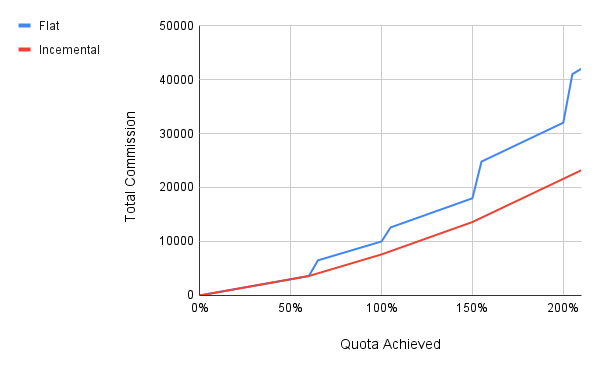The Ultimate Guide to Tiered Commission


Executive summary: In this article, we’ll cover everything you need to know about tiered commissions/incentives.
We’ve often seen big brands like Pepsi and Kellogg’s launch campaigns where consumers can win fabulous prizes by collecting bottle caps and cereal boxes.
The idea is the more points you collect, the better the reward.
When done right, this brilliant marketing strategy can skyrocket your sales!
Similarly, you can use a tiered commission/incentive structure to not only keep your salesforce motivated but your sales numbers ticking.
In this article, we’ll discuss what a tiered commission structure is, its pros and cons, and its benefits. We’ll also highlight a few tips to help you easily implement this structure.
A tiered commission structure is where sales reps are encouraged to sell more by being offered incrementally higher commission rates for exceeding sales quotas.
These quotas can be based on revenue, profits, number of deals closed, units sold, new customers acquired, etc.
A typical tiered commission structure might look something like this:

As you can see above, a tiered commission structure motivates sales reps to hit higher targets, rewarding star performers and pushing everyone to deliver their best.
If you are considering implementing a tiered commission structure here are some of the benefits you can expect:
When salespeople know they can earn more by selling more, they are incentivized to put in extra effort. A rep earning 5% commission on sales up to $50,000 might be motivated to close a $60,000 deal if they know they'll earn a 7% commission on the additional $10,000.
Want to boost sales for a new product? Set a higher commission rate on that product. A car dealership, for instance, might offer a higher commission for selling electric vehicles, promoting sustainability and aligning with their business goals.
Recognizing and rewarding performance through tiered commissions can boost morale and reduce turnover. T-Mobile's "Mobile Expert" program, for example, rewards sales reps who meet certain sales targets, enhancing job satisfaction and team performance.
Now that we've covered the basics of tiered commissions and their benefits, let's dive into the various types of tiers you can use to implement them.
Rewards the entire team when collective sales targets are met, promoting collaboration.
Assigns different rates to various products, incentivizing sales of higher-margin or harder-to-sell products.
For example, a SaaS company might offer a higher commission rate for its premium product than its entry-level product.
Based on individual sales metrics, motivating reps to exceed personal goals.
Sales performance metrics include meeting or exceeding their sales quota or maintaining a high customer satisfaction score.
Rewards reps more for acquiring new customers or selling to targeted segments.
For example, a company might offer a higher commission rate for sales to new customers in a specific region.
Combines elements of multiple tiers for a customized approach.
For example, a company might use a combination of team-based and product-specific tiers to incentivize reps to work together to sell specific products.
Design a tiered commission structure using this three-step process:
Sales quotas are time-bound and quantitative targets your sales team must achieve to earn commissions.
Here are a few examples:
Depending on the nature of your business, you will need to set sales quotas accordingly.
Check out our blog on how to set effective sales quotas.
In this step, we’ll group those sales quotas into performance tiers.
In the example above, the tiers were 0-60%, 60-100%, 100-150%, and so on. You can set your own tiers depending on your business goals.
Moreover, if your sales team is hitting their quota often, you can even set some tiers below and some above 100% quota attainment. On the other hand, if your sales team’s average quota attainment is about midway, you could set more conservative tiers (e.g., 0-40%, 40-60%, 60-80%, 80-100%, and 100-120%).
Pro-tip: Avoid loading your commission structure with too many tiers. A good range would be 4-5 tiers.
The next step is deciding what commission rates you want to offer for each tier.
This will require some research and planning. However, the bottom line is that you should ensure that the commission rates you offer are competitive enough to attract exceptional talent. At the same time, your finance team needs to vet the rates to ensure your cash flows aren’t affected.
Lastly, we’ll decide on the payout curve.
Let’s understand this with an example. If a sales rep has a target of $100,000 and the total sales they made is $120,000, their quota attainment is: 120%
Now, we have two scenarios here – flat and incremental payouts. And depending on the type of payout curve, reps can have different earning potentials.
A. Flat tiers

In flat tiers, reps would earn commission based on the flat commission rate for each deal they made.
Based on the tiers in Table 1.1, for 120% quota attainment, the rep would earn a flat 12% commission of the total sales made.
So, total commission = 12% of $120,000 = $14,400
B. Incremental tiers

Here, the commission will increase for each tier as follows:
Total commissions = $3,600 + $4,000 + $2,400 = $10,000
As you can see, there’s clearly a big difference between the two cases.
If you compare the payout curve, it would look something like this:

Flat tiers are suitable for industries like manufacturing, where most companies use a team-based commission structure – shifting the focus to collective performance rather than individual sales. This offers a consistent commission rate based on overall team performance.
While a flat payout can leave a considerable dent in your account after every commission period, you can use it to your advantage.
How?
If your sales team is continuously clustering at 60% of quota attainment, you can use flat tiers to give that much-needed extra push.
On the other hand, incremental tiers can benefit SaaS companies and product resellers where sales volume and customer acquisition are crucial. Even though you’ll end up paying more with each tier, incentivizing sales reps to sell more aligns with the recurring revenue model of these industries.
Let’s compare the advantages and disadvantages of a tiered commission structure:

Here are some scenarios where using a tiered commission plan might be just the change you need:
To successfully implement a tiered commission structure, always keep these three points in mind:
Tiered commission structures can get complex at times, increasing the probability of an error.
Errors in design could lead to your reps not focusing on the goals you’ve set out. Further, errors in commission calculations could seriously dampen your sales team’s morale.
The more transparent your plan, the greater its chances of success. And transparency comes with clear and constant communication.
Also, your reps should always have real-time visibility into their earnings. They shouldn’t have to wait till the end of the month or quarter to view how much they made in commissions. A sales commission software can help you in this regard.
This one holds for any commission structure. True story!
Delaying payments, even by a few days, can affect your sales team’s morale.
Your top performers can feel grossly mistreated as they put in all that effort to grow your business continuously. And your bottom sellers, who are probably already struggling to maintain morale, can sink further.
Sales commission and incentive software takes the guesswork out of calculating tiered commissions, ensuring everything is accurate.
ElevateHQ automates the most complex commission structures, and it is easy to set up with your data. You can integrate it with your CRM, spreadsheet, and any existing tool. You can create different plans, add reps, set up commission logic and approval workflows.